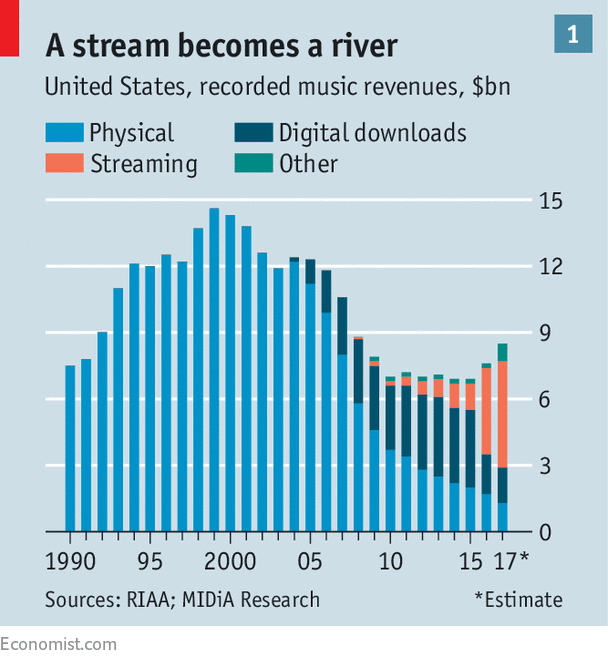The vast majority of all music revenue is coming from online streaming (paid music subscriptions). If you are an artist without an established fan base, then you are probably wondering how to sell your music…
I recently read an interesting article (3/20) which was published by reviews.com that had some interesting insight into how Spotify, among other streaming services makes their money & the current state of the streaming industry.

Before we jump in let’s clarify some industry terms:
Royalties: The amount paid to any rights-holders when a song is sold and/or distributed, used in movies, ads, or monetized in any way.
Each song is split into two separate copyrights:
Composition (lyrics & melody)
Sound recording owned by the record label and recording artists.
- Composition copyrights: Owned by songwriters and publishers
- Sound recording copyrights: Owned by the record label and recording artists
There’s Not A Lot of Money for the Artist in Streaming Royalties
Streaming services are funded by both advertisement and subscription-based revenue. If someone listens with a free account, advertisers pay the streaming service to interrupt your tunes with their ads. When you pay a monthly fee for a premium subscription, that money directly translates to a services’ revenue. The amount of revenue generated by a streaming service that trickles down to the artist is in my opinion abysmal. The service Digital Business News estimated that Napster had the highest rate of return at $.019 per stream, while YouTube’s streaming service offers the smallest payout at $.00074 per stream. Apple Music is the third-highest after Napster and Tidal with $.00735 per stream. It would take tens of thousands of plays at those prices to make a minimal wage in the U.S. and millions of plays to make enough to support a small family.
Adweek calculated that about one million plays on Pandora generates $1,650 for the artist and nearly $7,000 on Spotify. The most popular artists will regularly surpass one million streams. Spotify’s top track in December of 2017 was Ed Sheerhan’s “Shape of You” with 1.4 billion streams. The Economist reported that, “On average a billion streams on subscription services brings in about $7m for big labels, with perhaps $1m of that going to the artists.” Not so bad if you’re one of the few chart-topping music acts today.
For musicians and bands striving to build a fan-base it is a different story. The nonprofit Music Industry Research Industry along with Princeton University) conducted a survey of over 1,200 U.S. musicians and found the average musician made about $35,000 in 2017 (approximately $21,000 from music-related sources). 61% of those musicians stated that their music-related income did not support living expenses.
The big names have also chimed in about the complicated relationship with streaming services and artists. In 2014, Taylor Swift pulled her entire discography from Spotify, sighting that streaming was the main reason for her shrinking album sales. In her Wall Street Journal op-ed Swift said,”It’s my opinion that music should not be free…and the pay rates haven’t improved by much.”
The Industry Continues to Navigate Streaming Services
Earlier this year the CRB (Copyright Royalty Board) signaled that streaming services had to increase royalty payouts by 44& over the next 4 years. Spotify, Amazon, Google, and Pandora have responded by filing an appeal in the federal courts. Apple Music chose not to appeal.
The federal government is getting behind songwriters too, with the new Music Modernization Act (MMA) of 2018. It is legislation aimed at increasing songwriter payout portions and streamlining the complex copyright rules. The MMA is composed of three parts:
- The Musical Works Modernization Act: a mechanical license for reproduction and distribution of musical works through downloading and streaming services. A nonprofit entity will be formed, tasked with administering the license and monitoring royalty payments. Also will help better facilitate royalty payments to artists.
- The Classics Protection and Access Act: will make sure that legacy artists’ work recorded prior to 1972 are paid royalties when played on digital radio.
- The Allocation for Music Producers Act: officiates a legal process for music professionals (producers, mixers, engineers, etc.) to receive royalty payments.
Streaming is Still A Great Idea for Artists
Regardless of the dismal payout for most artists, YouTube Music and other streaming sites are still invaluable tools for artists. I believe that streaming sites be thought of and used much like the radio once was . Streaming services exist for music discovery and promotion and a tool for artists to get their music out there, to be heard by an audience that wouldn’t normally have access to their music. With streaming and the possibility of being put on someone’s playlist, the opportunity to get discovered by new listeners opens the doors to a potentially huge audience. Independent artists can connect to fans easier than ever. It is much easier to discover a band on Amazon or Apple with curated and obscure playlists. Touring headliner Odesza earned their fanbase by posting music for free on Soundcloud and Spotify. I recently read an interview by hip-hop artist Jaleel Koth who said “Streaming has opened up a new door for undiscovered talent to build their legacy independently. Artists can begin to earn money and build an audience base before they’ve signed with a record label and without investing in a tour.”


Comments are closed.